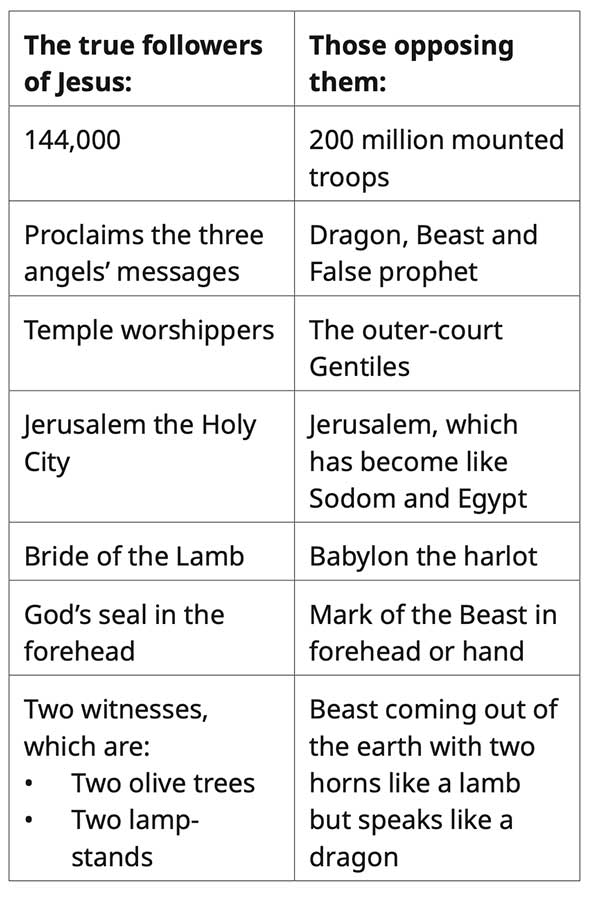
Revelation Hope – Two Witnesses Put to Death
Revelation 11
The Lamb has been loosing the seals. Now the book is open and John takes the book as a representative of all true believers—and eats it (see Revelation 10:9-11).
The message from the open book is good news and brings joy to our hearts when we receive it.
But there will also be bitterness experienced as many reject both the good news and those who proclaim it.
This has been the situation throughout the history of the church.
Revelation now describes this opposition as the gospel is proclaimed to the world.
The timing of these events is to take place just before the seventh trumpet sounds (see Revelation 10:7 and 11:15). In effect, this means the world is living under the horrific conditions brought about by the sounding of the sixth trumpet.
Chapter divisions were not part of the original Bible, so we need to get the setting from Revelation 10 or we will go in a wrong direction as we approach Revelation 11.
Like Revelation 10, this chapter has three parts:
1. Revelation 11:1-2: the temple.
2. Revelation 11:3-6: the identity of the two witnesses.
3. Revelation 11:7–13: the death and resurrection of the witnesses.
The fact that the same time period is mentioned in parts 1 and 2 (“forty-two months,” “1,260 days”) indicates that verses 1-6 all address the same period of history.
In terms of history, then, Rev 10:8 – 11:13 cover three periods of history:
Revelation 10:8-11 is addressed directly to John in his day.
Revelation 11:1-6 is future from John’s day and makes reference to Daniel’s time prophecies (1,260).
Revelation 11:7-13 relates to the final period of earth’s history, after the close of Daniel’s time prophecies (Rev 10:5-7), the period Daniel calls the Time of the End.
Revelation 11 as a whole describes the experience of God’s people from John’s day until the End, with special emphasis on the final events of earth’s history.
This chapter deals with:
• Attacks upon the church throughout Christian history (Rev 11:3–10).
• The safety and preservation of God’s followers at the End (11:11–13).
• The ushering in of the kingdom of God (11:15–17).
• The judgments of God upon those who reject the gospel (11:18).
Although it has some bad news, it also gives exciting news.
If rightly understood, this can bring great encouragement to us,
and perhaps issue a challenge as it reveals more details on how the end-time conflict will take place.

The Big Picture
The sounding of the trumpets shows God’s actions in history to bring preliminary judgments on the inhabitants of the earth. As God is seeking to win them to Himself, He issues warnings that the seven plagues will come once He closes the door of opportunity to the world.
Between the breaking of the sixth and seventh seals, there is an interlude to show what is happening to the church. That interlude has been pictured as also occurring between the sixth and seventh trumpets. The church has been called to preach the gospel but in doing so, she faces hostility just as Jesus did.
These events take place while the sixth trumpet is still sounding. They reach down to the time just before the sounding of the seventh trumpet and the consummation of all things.
Connection to the Gospel Going Worldwide
We know Revelation 10 is talking about the gospel, the finishing of the “mystery of God” (see Revelation 10:7).
Jesus said the last great event before the end will be the gospel going to the world (see Matthew 24:14, 15).
He also warns His followers to be aware of the prophecy regarding the “abomination that causes desolation” standing in the holy place, as revealed in the Book of Daniel.
We saw the primary meaning was the Roman armies surrounding Jerusalem, as stated by Luke in his account of the same sermon (see Luke 21:20).
But similar kinds of events are predicted for the end of time, particularly in the book of Daniel and the second half of Previously, we saw the Lamb loosening the seals—now the book is open and John takes the book as a representative of all true believers—and eats it (see Revelation 10:9-11).
The message is good news—sweet as honey—bringing joy to our hearts when we receive it.
But there will also be bitterness with it as well.
As those who choose to follow Jesus preach the gospel, there will be some bitter experiences, for not all see the gospel as good news.
It is embraced by many but violently rejected by others.
End-time Hostility to the Gospel
The bitterness of Revelation 10:9–11 has a powerful counterpart in the death of the two witnesses as described in Revelation 11:7–10.
It seems the preaching of the open scroll brings about a bitter experience for those who distribute the sweet message of the gospel.
This bitter experience (or suffering) is to be worldwide, since the preaching is to go to “many peoples, nations and tongues” (see Matthew 24:14; Revelation 10:11, 14:6).
The faithful followers of Jesus are described in chapter 11 as:
• The Holy city.• The two witnesses. • The two olive trees. • The lamp stands.
This hostility that comes in reaction to the preaching the gospel is mentioned by many biblical writers using different expressions:
Jesus talks of it in Matthew 24:14, 21 and 22. The preaching of the gospel precipitates “great tribulation” in the course of Christian history.
Jesus speaks about it in different terms in John 15:18–21.
If people hated Jesus, we should not be surprised if they hate Jesus’ followers.
Daniel describes it in Daniel 11:40-45 as the King of North surrounding the holy mountain.
Then in Daniel 12:1, he states that Michael stands up and delivers His people at that time.
The Book of Acts describes how the followers of Jesus in the first generation preached the gospel in the face of much opposition.
First Peter (2:20–21; 4:12–16) relates the suffering of Jesus’ followers to the example that He set before them.

Revelation 12:17 talks of the dragon being enraged with the woman. He then goes to make war with the rest of her offspring.
• Revelation 13 talks of a beast power, the setting up of an image to the beast and the enforcing of its mark.
• Revelation 16 talks of spirits of devils working miracles, gathering the kings of earth for battle of Armageddon.
• Revelation 17:14 describes a war between the Lamb and His followers, and the powers on the earth.
• Revelation 19:11-21 describes Christ leading the armies of heaven to fight against the dragon, the beast and the false prophet.
Evidently, God wants His people to be aware of what is to happen and be prepared for it.
It’s all about keeping our hold and trust in Jesus.
Whether we like it or not, we are caught
up in a holy war.
Because of this, it can be intimidating to faithfully preach the good news. There is bitterness associated with it.
Revelation 11 has a number of remarkable parallels to Revelation 13, which talks about two beasts. Notice the similarities:
• Revelation 11:7—The beast of the abyss
makes war against the two witnesses and overcomes them.
• Revelation 11:11—The two witnesses bring fire out of their mouths to devour their enemies. They are put to death but a breath of life from God enters them. They revive and stand on their feet.
• Revelation 13:7—The beast out of the sea makes war against God’s people and overcomes them.
• Revelation 13:15—The lamb-like beast brings fire down from heaven to deceive and brings the breath of life to the image of the first beast so it can speak.
The parallels between the two witnesses and the land beast are startling.
They are described in similar ways yet are clearly on different sides.
The similarities between the two witnesses and the land beast are a foretaste of the deception that occurs at the end of time, when people will confuse the work of God with the work of Satan.
Also the experience of the two witnesses (witnessing 16 in sackcloth and then in death) will be repeated by the experience of the end-time remnant in 13:15–17.
The final proclamation of the Gospel occurs in Revelation 11:11–13.
This continues until the close of the sixth trumpet (see Revelation 10:7; 11:14).
This is the fulfilment of the predictions that the “mystery of God” would be finished before the seventh trumpet sounds (see Revelation 10:7) and that John would once again preach to many people and nations (see Revelation 10:11).
What is the message to be preached? We have already had some significant hints in chapter 10. The end–time message will
* include the preaching of the gospel (see Revelation 10:7),
*will have strong reference to the Book of Daniel in the Old Testament (see Revelation 10:5–6)
* will include a renewed proclamation of the book of Revelation (see Revelation 10:11).
But the first verses of chapter add an additional element to the proclamation.

Evaluation by Measuring & Counting
The heart of the message in these verses has to do with the measuring the temple of God, the altar and those who worship in the temple.
The word “measure” is used in the Bible to describe evaluating or judging (see, for example, 2 Corinthians 10:12).
In Old Testament times, a similar word was used for a measuring that involved judgment as to who would live and who would die (see 2 Samuel 8:2).
The “measuring” here is a foretaste of the judgment that takes place before the second advent of Christ (see Revelation 14:7).
The language of the temple, altar and worshippers parallels language associated with the Israelite Day of Atonement.
The priest is not mentioned here because the priest is now Christ, ministering in the heavenly sanctuary.
But Where is this Temple of God?
In the New Testament, the fundamental meaning of temple is Jesus Himself.
According to John 2:19-21, Jesus’ body is a temple, housing the very presence of God (see also Matt 12:6).
This direct imagery is never used in Revelation.
There are also three extended meanings of the temple in the New Testament:
1. The church can be described as a temple of God, with the believers functioning as living stones in its structure (see 1 Corinthians 3:16; 1 Peter 2:4–5).
2. The human body can also be described as a temple (see 1 Corinthians 6:19–20), housing the living presence of Christ through the Holy Spirit (see Colossians 1:28).
3. The book of Hebrews strongly emphasizes the idea of a temple in heaven, where Jesus sits at the right hand of God (see Hebrews 8:1–7; 9:23–24).
The concept of the body temple is clearly not in view in Revelation 11.
The church as temple is also not in view, since believers are portrayed, not as the temple, but as worshippers in the temple (see Revelation 11:1).
So John is picturing the temple of God in heaven, the place where Jesus ministers for us now. He constantly refers to it and its furnishings, using the language of the earthly Old Testament temple.
The Altar
This is the golden altar before the veil in the Holy Place.
It would not be the altar in the outer court, as John was told not to measure the outer court at all.
This altar would be the same altar mentioned in Revelation 8:3-6, where we have incense mingling with the prayers of God’s people.
As a result of the preaching commissioned in Revelation 11:11, the church is measured and divided.
Some are true worshippers but others are excluded.
The Outer Court
This was the court of the Gentiles. It was an uncovered court where the Gentiles could assemble but not pass to the inner court beyond a barrier, under penalty of death.
The word used for “Gentiles” can also be translated “nations.”
John used this word in Revelation to describe those forces hostile to God and His people.
By contrast, the faithful are found in the temple itself.
With preaching comes measuring, which determines who is to be sealed
This ongoing process of judgment will reach a climax in the period just before Jesus comes (see Revelation 10:7; 14:7).
Those who are not following Christ faithfully are cast out (see Revelation 11:2—often translated “leave it out” but the Greek is stronger) to the outer court with the Gentiles.
This is where the altar of sacrifice is placed it represents the earth, where Jesus was crucified.
This world belongs to those not following Christ.
Dividing by Separation
Preaching the gospel brings judgment, dividing the world into two groups.
At the end of time it will divide even the professed church of Christ.
The “casting out” (see Revelation 11:2) can only happen to those who were once within the courts of the house of God.
Revelation 11:1, 2 tell us that the outcome of the preaching described in Revelation 10:11 will divide the world into two camps.
Those who respond favourably are deemed to be found worshipping in the temple itself, while others will be excluded to the outer court of the Gentiles, among those who are not God’s people.
It is the Gentiles—those who are not God’s people—who give the church a difficult time for 42 months.
This time period is mentioned many times in Daniel and Revelation.
It is sometimes called 42 months; in other places, it is 1,260 days or three-and-a-half “times.”
These same time periods are mentioned again in Revelation 12 and 13, speaking about an extended period when God’s people are having a difficult time.
We will learn more about the opposition to God’s people during those times when we cover the chapters to come.
The church is described in Revelation 11:3 as being two witnesses prophesying in sackcloth for 1,260 days.
This is the same event as the Gentiles trampling on the holy city for 42 months..

Identification of the Two Witnesses
In these verses the two witnesses are pictured as prophesying in sackcloth—the garments of mourning—for 1,260 days.
They are following in the footsteps of Jesus, who preached for three-and-a-half literal years, as one who was despised and rejected by men.
The concept of having two witnesses derives from the Jewish legal system, which requires at least two witnesses for something to be established as true (see Deuteronomy 19:15).
John portrays the two witnesses as standing all alone, challenging the wrongs of their day and representing God in the face of great opposition as they proclaim the good news about Jesus.
The imagery of the two witnesses points both to the people of God and to the Bible (see special interest topics for more detail).
The two interpretations are not contradictory.
It is hard to separate the church from the Bible because the church is called to preach the Bible as the word of God.
When it faithfully does this, amazing things happen—and opposition arises.
In Revelation 11:4–6, the way John talks of the two witnesses suggests they are primarily the church of both the Old and New Testaments.
The description of God’s people as witnesses shows how important witnessing is in church life, which is God’s expectation for His people.
If we are Christians, we will want to tell others of our hope in Christ.
The true followers of Jesus did this for 1,260 days mentioned in this text. In Revelation 12, we will see evidence how those “days” are not to be taken literally.
They represent a long period of time lasting more than 1,000 years, roughly equivalent to the period of history we sometimes call the “Dark Ages.”
The good news proclaimed, is so important that it has to be established by two witnesses.

Two olive trees
= the two witnesses = the people of God
In verse 4, we see two olive trees—imagery from Zechariah 4—where the prophet saw
a lamp-stand with seven lamps between two olive trees in vision.
In Zechariah the two trees are said to represent God’s “two anointed ones” Joshua, the high priest, and Zerubbabel, the governor of Judea.
John adjusts the imagery with two olive trees and two lamp-stands. He is representing the people of God as both kings and priests, as proclaimed in Revelation 1:5 and 5:10.
Elijah & Moses
= the two witnesses
In verse 6, John further portrays the witnesses in terms of Moses and Elijah, who represented God despite experiencing great opposition.
Although they suffer for the message, they are not powerless: “fire comes from their enemies.”
• Consider what happened to those who came to arrest Elijah: fire devoured them. Elijah’s prayers also brought fire from heaven on Mt Carmel (see 1 Kings 18:20- 40).
• Consider what happened to Pharaoh and the Egyptians when they messed with Moses: the first plague turned water into blood (not good in a dry land) followed by plague after plague
(see Exodus 7:14- 11:10)
.
So this is a warning to those who oppose the preaching of the good news about Jesus: be careful in what they do.
Two witnesses
= the end-time followers of Jesus
Revelation pictures the people of God and their opponents in a variety of contrasting images. Basically, each pair of images is telling a similar story.

Revelation pictures the people of God and their opponents in a variety of contrasting images.
Basically, each pair of images is telling a similar story.
Forces of the Antichrist Power
The experiences of those who wish to follow Jesus are mirrored in the life of their leader.
Read Revelation 11:7-10Notice that in verse 7, the two witnesses finish their “testimony” (which is described in verse 3 as prophesying for 1,260 days—“witness” and “testimony” are based on the same Greek root word).
When they completed their gospel testimony at the end of the 1,260 days, they faced the bitter experience of martyrdom (see Revelation 11:7; 10:8–10).
When Jesus had finished His testimony, He was put to death but then rose again and ascended to heaven.
The experiences of those who wish to follow Jesus are anticipated in the life of their leader.
The Price Paid for Witnessing
Revelation 11:10 says the people of the earth were tormented by the two witnesses.
Their dead bodies will lie in the street of the great city. It is a disgrace for dead bodies to not get a burial.
They now suffer indignity—rejected by the world, even in death.
Those who did this to them are now described as the great city, which figuratively is like:
• Sodom—known for its immorality;
• Egypt—known for Pharaoh’s self- sufficiency and refusal to acknowledge the true God;
• Jerusalem—where Jesus was crucified.
What happened to Jesus in Jerusalem now happens to His witnesses.
It is all linked to the death of Jesus. Here are His followers facing their Calvary.
The last days of Christ are seen as a way of describing what will happen to His followers as they approach the End.
The High Cost Involved with Following Jesus
The Time of the End is a grim time for those who choose to follow Jesus: facing great persecution and humiliation, without even a decent burial.
In verse 10, the inhabitants of the earth celebrate and send gifts to each other.
As happened with the death of Jesus (see Luke 23:12), those who are enemies work together in a common cause.
The world will unite against them.
They will want to rid the earth of them because the preaching of the good news about Jesus has tormented them.
As the true gospel continues to be preached through to the end of human history, it is empowered by the work of the Holy Spirit in a special way.
As it has all along, this will draw the attention of the world and stir up enormous opposition, empowered by spirits of devils working miracles.
In Revelation 10:11, John was told to preach again concerning “many peoples, nations, languages and kings.”
But most reject both the message and the messengers.
The Witnesses are Raised Like Jesus
Read Revelation 11:11-14There was rejoicing among His enemies when Jesus was put to death—but then came His resurrection. As was Jesus, so His followers (represented by the two witnesses) are now pictured as being resurrected. God breathes new life into them. They are raised to heavenin a cloud, in full view of their enemies.
Remember regarding Jesus’ death and resurrection: Jesus’ enemies were reconciled to each other.
At the cross, there was darkness and an earthquake.This was followed by His resurrection and ascension.
The rejoicing of the world is interrupted once again. The resurrected witnesses are placed where their enemies can observe them and terror strikes at the heart of the inhabitants of the world.
The resurrection of the two witnesses could be linked with the preaching of the first angel’s message (see Revelation 14:6) as they are caught up to heaven in a cloud.
This is the preaching of the everlasting gospel, symbolised by an angel flying in the midst of heaven.
The call is made to fear God and give Him glory. He is the Creator who made heaven and earth (see Revelation 14:7). This is the final proclamation of the gospel to the world.
As a result of this proclamation and the upheavals in the world, an earthquake in verse sees a tenth of the city collapse and 7,000 killed.
Some who survive respond to this preaching by giving glory to God.
The word for “terrified” in 11:13 has the same root as “fear” God in Chapter 14:7.
Some think this expression is used here as a way of telling us that some non-believers in Jesus will find faith in Him as a result of the experiences of the two witnesses and the earthquake. They think this because both concepts “fear God” and “give Him glory” are found here.
The language of Revelation 11:13 and 14:7 could be telling us that just before the end—before God closes the door at the sounding of the seventh trumpet—there will be some who come to Christ.
Alternatively, these verses could mean the survivors are those who have been faithful to Christ long before this time and even they are terrified what they see. The word for “survivor” is the same word translated “rest” or “remnant” in Revelation 12:17, where it mentions a people who stay faithful to God throughout this crisis.
The second woe has passed and now the third woe is coming.
God’s Kingdom Proclaimed
Read Revelation 11:15
The sounding of the seventh trumpet signals the close of human probation. It is a time when God reclaims the world He has created and takes it over as His kingdom forever.

Tying it all Together
This chapter has much to say to the followers of Jesus who experience the end-time events of the gospel being preached to the world.
Remember, we are kings and priests, like Christ our Master, and they will treat us as they treated Him. But they cannot harm our life in Christ, for God has measured us, secured us and sealed us.

In the courtyard of this earth where Christ has suffered,
we may lose this earthly life but the life hidden in Christ cannot be hurt.
In the end, we will be vindicated while those who oppose us will suffer the consequences of the judgments of God.
We will see more in the next session as we look at the overture to the rest of the book of Revelation.
For a little more……..